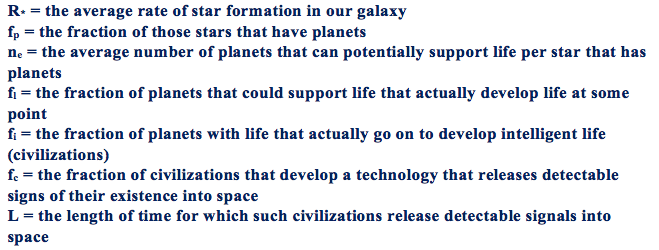Is there anyone there; does anyone care out there?
|
In the past, I have written many essays about science. Additionally, in an attempt to be honest with my readers, I have also mentioned many times that I have only a total of 10-hours in the sciences out of my nearly 300-hours at college, graduate, and post-graduate studies. That was a 10-hour geology class a half century ago. Nonetheless, science fascinates me especially areas involving space sciences. Things from the big bang to the number of galaxies, suns, and planets out there intrigue me. Out there in the vastness of space, is there intelligent life looking back at us?
Is there anyone there; does anyone care out there? Stephen Hawking, one of the greatest minds of astrophysics, mixed science and humor with this comment: "Primitive life is very common, and intelligent life is very rare." Then he quipped, "Some would say it has yet to occur on Earth." Aside from the humor, the issue of intelligent life out there in the vastness of the universe peaks my curiosity. Therefore, this essay is my attempt to fathom something about which I have no formal schooling. What is the chance of some intelligent being out there? Is there anyone there; does anyone care out there? We need to consider various issues regarding intelligent life forms light years from us.
In order to determine the number of planets, we need to get an approximate number of galaxies in observable space. Those in the know believe that there are probably more than 200 billion galaxies out there in our ever-expanding cosmos. This photo is of Superclusters of galaxies Then multiply 200-500 billion galaxies times an estimated average number of suns per galaxy. Scientists estimate the number of stars to be 100 octillion give or take a couple of billion of stars. Then multiply that number with an estimated number of planets per star. Some astronomers after doing the math come up with 50 sextillion planets in the universe.
If the universe contains 50 sextillion planets, how many planets have what we call intelligent life? Many would have or had single cell up to multicellular organisms. However, the question is about how many planets have highly developed forms of life capable of thinking at least at our level. Enter, Dr. Frank Drake, the founder of SETI, which is an anachronism for Search for Extraterrestrial Intelligence. He came up with mathematical formula, which guesses at the number of possible intelligent beings in the universe. This is Drake's equation.
Drake's formula attempts to determine intelligent life in just our galaxy, the Milky Way. Therefore, N is that number of planets that could possibly contain intelligent life. However, there a many variables that will affect the answer. The following is what makes up the number of planets.
This next chart is a picturesque attempt to explain for those of us without the science and/or math.
The problem with the mathematical formula is the most of that variables are sheer guesses and the couple that are not sheer guesses are just guesses. So do the math. Many of those in the know have done the math with this result: N = 4 x 0.5 x 0.25 x 0.2 x 0.2 x 0.2 x 3,000,000, which would yield that within the Milky Way, there are about 12,000 planets with some form of intelligent life. Interestingly, Drake also did the math and came up with 10,000. Therefore, among the astrophysicists, many including Drake, come up with very similar data. In an attempt to add some literary humor to science, many of those in astronomy refer to possible intelligent beings in the Goldilocks Zone. This zone is neither too hot nor too cold but just right like Goldilocks eating the porridge of The Three Bears. The red dwarf star, Kepler-438, which is some 470-light years from us, has 8-planets thought to be very similar to ours. Kepler's eight possible planets containing possible intelligent life
This shows the Kepler and Earth's habitable or Goldilocks zones
The next issue has to do with hearing and then communicating with other cosmic intelligent beings. This assumes that we are able to communicate with them. The next issue is the time spent sending and receiving message between us. If one of those planets sent us a message, it was 470-light years ago. They would have gotten tired of waiting for a response from us.
Dr. Ellie Arroway, in Contact, is listening for some sort of communication from outer space. I have done some very foolish things in my life, but Dr. Arroway's attempt is beyond the pale if she wanted to communicate to intelligent beings in a Goldilocks Zone. Even if she heard something or some signal, we are making the assumption that an intelligent being will still be alive light years from us. In fact, the planet, its sun, and/or the galaxy could have already imploded.
If communicating with some intelligent being in the Kepler Goldilocks Zone of eight planets, it would take a great deal of time. Present-day spaceship can travel 25,000 miles per hour, which mean that it would take about a million years to travel that distance to Kepler 438, which is in the constellation of Lyra. Therefore, in our Milky Way galaxy, there may be 10-12,000 planets upon which some sort of intelligence might exist. However, if we met for a caffè misto at Starbucks, it will be because they are the time travelers not us.
Visit the Connecting the Dots page to read more about this topic. 08/10/15 Follow @mountain_and_me |
















